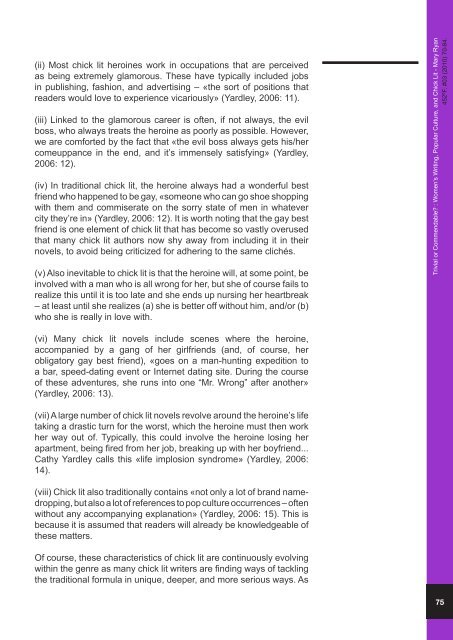03 - 452ºF
03 - 452ºF
03 - 452ºF
You also want an ePaper? Increase the reach of your titles
YUMPU automatically turns print PDFs into web optimized ePapers that Google loves.
(ii) Most chick lit heroines work in occupations that are perceived<br />
as being extremely glamorous. These have typically included jobs<br />
in publishing, fashion, and advertising – «the sort of positions that<br />
readers would love to experience vicariously» (Yardley, 2006: 11).<br />
(iii) Linked to the glamorous career is often, if not always, the evil<br />
boss, who always treats the heroine as poorly as possible. However,<br />
we are comforted by the fact that «the evil boss always gets his/her<br />
comeuppance in the end, and it’s immensely satisfying» (Yardley,<br />
2006: 12).<br />
(iv) In traditional chick lit, the heroine always had a wonderful best<br />
friend who happened to be gay, «someone who can go shoe shopping<br />
with them and commiserate on the sorry state of men in whatever<br />
city they’re in» (Yardley, 2006: 12). It is worth noting that the gay best<br />
friend is one element of chick lit that has become so vastly overused<br />
that many chick lit authors now shy away from including it in their<br />
novels, to avoid being criticized for adhering to the same clichés.<br />
(v) Also inevitable to chick lit is that the heroine will, at some point, be<br />
involved with a man who is all wrong for her, but she of course fails to<br />
realize this until it is too late and she ends up nursing her heartbreak<br />
– at least until she realizes (a) she is better off without him, and/or (b)<br />
who she is really in love with.<br />
(vi) Many chick lit novels include scenes where the heroine,<br />
accompanied by a gang of her girlfriends (and, of course, her<br />
obligatory gay best friend), «goes on a man-hunting expedition to<br />
a bar, speed-dating event or Internet dating site. During the course<br />
of these adventures, she runs into one “Mr. Wrong” after another»<br />
(Yardley, 2006: 13).<br />
(vii) A large number of chick lit novels revolve around the heroine’s life<br />
taking a drastic turn for the worst, which the heroine must then work<br />
her way out of. Typically, this could involve the heroine losing her<br />
apartment, being fired from her job, breaking up with her boyfriend...<br />
Cathy Yardley calls this «life implosion syndrome» (Yardley, 2006:<br />
14).<br />
(viii) Chick lit also traditionally contains «not only a lot of brand namedropping,<br />
but also a lot of references to pop culture occurrences – often<br />
without any accompanying explanation» (Yardley, 2006: 15). This is<br />
because it is assumed that readers will already be knowledgeable of<br />
these matters.<br />
Of course, these characteristics of chick lit are continuously evolving<br />
within the genre as many chick lit writers are finding ways of tackling<br />
the traditional formula in unique, deeper, and more serious ways. As<br />
Trivial or Commendable? : Women’s Writing, Popular Culture, and Chick Lit - Mary Ryan<br />
<strong>452ºF</strong>. #<strong>03</strong> (2010) 70-84.<br />
75










